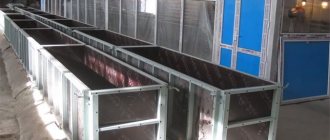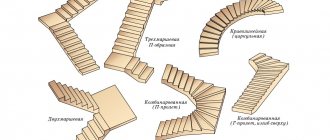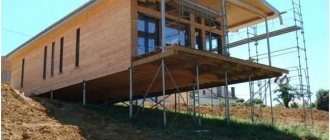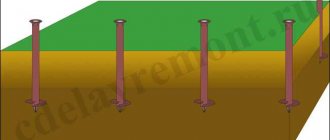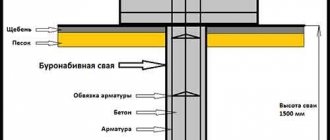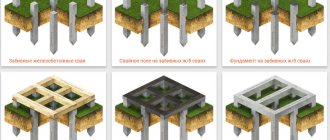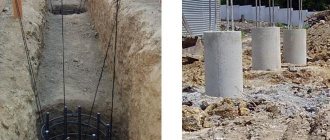Screw piles are an inexpensive and reliable type of foundation for the construction of lightweight buildings on soft soils.
In order for the foundation to serve properly for the entire allotted period, it is necessary to study the geology of the site, find the design loads and, based on the data obtained, select the desired configuration of the supporting elements.
In this article we will discuss the sizes of screw piles, what they should be for the foundation to be reliable and how to choose the right size.
Element parameters for building a strong foundation
The range of metal screw piles on the domestic market will surprise the novice builder with its diversity.
Manufacturers offer support elements that differ in diameter, length and weight.
These parameters change the resistance of the foundation to loads , so they must be taken into account in pre-design calculations.
For the construction of light and low-rise structures, pipes with an outer cross-sectional diameter ranging from 57 to 159 mm are usually used. But for areas with difficult soil and for heavy buildings, it is advisable to choose supports with a pipe diameter of more than 200 mm.
For soils with close occurrence of underground sources and a freezing point at a depth of 1.5 m, piles 1.65 m long are suitable, but in waterlogged soils, the height of the pillar can reach 9 m. In this case, the thickness of the walls of the steel pipe and blades should be equal to or greater than 4 -5 mm.
When choosing a structure, builders pay attention to its mass, which in turn is related to the length and diameter of the support.
The relationship between the parameters is shown in the table:
| D, mm | Weight (kg) depending on support length (m) | |||||||||||
| 1,6 | 2 | 2,5 | 3 | 3,5 | 4 | 5 | 6 | 7 | 8 | 9 | ||
| 57 | 11 | 12 | 14 | 16 | 18 | 20 | 24 | 28 | 32 | 36 | 40 | |
| 76 | 12 | 14 | 17 | 19 | 22 | 25 | 30 | 36 | 42 | 48 | 53 | |
| 89 | 14 | 17 | 20 | 23 | 26 | 29 | 36 | 42 | 48 | 54 | 60 | |
| 108 | 22 | 25 | 30 | 35 | 40 | 45 | 55 | 65 | 75 | 85 | 95 | |
| 133 | 27 | 31 | 38 | 44 | 51 | 57 | 70 | 84 | 94 | 110 | 124 | |
| 159 | 38 | 45 | 55 | 64 | 74 | 83 | 102 | 121 | 140 | 159 | 178 | |
In most cases, for private housing construction, builders choose pipes with a diameter of 108 mm and at least 2 m.
When constructing gazebos, bathhouses and garages, you can use supports with smaller dimensions: d 76 mm by 1.5 m or d 89 mm by 2.0 m.
Some types of fences also require laying a foundation, and the diameter of the pile can be from 54 to 108 mm.
Load-bearing structures with a diameter of 108 mm are considered the most common type of screw supports and are used in the design of most types of structures. The stability of the foundation directly depends on the length of the element, so special attention is paid to the value of this parameter.
Experts note that it is better to choose a longer pile, because if necessary, it is much easier to cut it than to build it up if the height of the foundation is insufficient.
Characteristics of screw piles and their sizes
Screw piles have different characteristics. There are not many of them: the most important are the length, cross-sectional diameter and mass of the element. Also, for use in construction, it is important to know the properties of the material that serves as the raw material for the manufacture of a specific brand of piles, and a number of additional parameters.
The technology of using screw piles in construction has a history of several centuries. During this period, the products have proven their practical value and have earned widespread use for the construction of buildings and structures of various characteristics and purposes.
The sizes of screw piles vary greatly, but all of them are designed with practical value and optimal use in construction in mind.
WEIGHT, MASS AND DIMENSIONS OF SCREW PILES
Screw piles have weights and dimensions developed and approved strictly in accordance with GOST standards. And regulatory documents, in turn, are based on numerous practical tests and examinations. During this multi-stage process, it was possible to select the optimal dimensions taking into account the load-bearing characteristics.
Screw pile dimensions
The table below shows the correspondence of the diameters and lengths of the pile to the working mass of the structural element.
| Pile length, m | Pile diameter, mm | ||||||
| 57 | 76 | 89 | 108 | 133 | 159 | ||
| 1650 | 11 kg. | 12 kg. | 14 kg. | 22 kg. | 27 kg. | 38 kg. | |
| 1800 | 11 kg. | 13 kg. | 15 kg. | 23 kg. | 29 kg. | 41 kg. | |
| 2000 | 12 kg. | 14 kg. | 17 kg. | 25 kg. | 31 kg. | 45 kg. | |
| 2500 | 14 kg. | 17 kg. | 20 kg. | 30 kg. | 38 kg. | 55 kg. | |
| 3000 | 16 kg. | 19 kg. | 23 kg. | 35 kg. | 44 kg. | 64 kg. | |
| 3500 | 18 kg. | 22 kg. | 26 kg. | 40 kg. | 51 kg. | 74 kg. | |
| 4000 | 20 kg. | 25 kg. | 29 kg. | 45 kg. | 57 kg. | 83 kg. | |
| 4500 | 22 kg. | 27 kg. | 32 kg. | 50 kg. | 63 kg. | 93 kg. | |
| 5000 | 24 kg. | 30 kg. | 36 kg. | 55 kg. | 70 kg. | 102 kg. | |
| 5500 | 26 kg. | 33 kg. | 39 kg. | 60 kg. | 76 kg. | 112 kg. | |
| 6000 | 28 kg. | 36 kg. | 42 kg. | 65 kg. | 84 kg. | 121 kg. | |
| 6500 | 30 kg. | 39 kg. | 45 kg. | 70 kg. | 90 kg. | 131 kg. | |
| 7000 | 32 kg. | 42 kg. | 48 kg. | 75 kg. | 97 kg. | 140 kg. | |
| 7500 | 34 kg. | 45 kg. | 51 kg. | 80 kg. | 103 kg. | 150 kg. | |
| 8000 | 36 kg. | 48 kg. | 54 kg. | 85 kg. | 110 kg. | 159 kg. | |
| 8500 | 38 kg. | 51 kg. | 57 kg. | 90 kg. | 116 kg. | 169 kg. | |
| 9000 | 40 kg. | 53 kg. | 60 kg. | 95 kg. | 124 kg. | 178 kg. | |
The diameter of screw piles is a key parameter when used in construction. The length can be changed by simply cutting the original rod, but the diameter is specified in the project and, taking this into account, is manufactured in production. An architect, when choosing a pile-screw type of foundation for a future structure, must accurately calculate not only the parameters of the foundation, but also the optimal dimensions and characteristics of the piles.
Weight, size, weight and other characteristics of screw piles
Let's consider screw piles, the dimensions and characteristics of which play an important role in the formation of the bearing capacity of the foundation. Average load-bearing capacities have been established for each type of pile: for example, a diameter of 76 mm provides reliable support for a load of 3 tons; diameter 108 mm increases the load-bearing capacity to 5-7 tons. The peculiarity of the design is that the weight of the pile itself does not affect the load-bearing characteristics of the future foundation.
The most common pile length is 2.5 meters. This value ensures the reliability of the structure and the quality of the foundation for any type of building. In general, in the modern construction market there are piles with a length from 0.5 meters to 11.5. Although most of them are rarely used in production.
As already mentioned, the weight of a 108 mm screw pile is capable of providing sufficient support for a load of up to 7 tons. The conclusion follows that the design of the pile serves as the best example of the rational use of materials. With minimal investment and strict adherence to the project, it is possible to create buildings of high strength and safety.
SCREW PILES: RELATIONSHIP OF DIMENSIONS AND ALLOWABLE LOAD
When organizing construction, you should carefully approach the development of the project - this way you will get an excellent result and reduce not only the costs and time of work, but also the risks of structural deformations over time.
The dimensions of the pile provide a certain indicator of the load that they can withstand. When calculating piles, it is necessary to know all the structural elements and parameters of each part of the structure. The architect analyzes the materials used in construction, the design of the building, the load on the foundation and much more. Only after careful calculation can you determine the best type of pile, without unnecessary expenses and with sufficient strength.
When calculating piles, a certain percentage is included “for a safety margin” - this is mandatory and is described in the project.
WHAT PILE DIAMETER TO CHOOSE
Large-diameter screw piles guarantee high strength, but when constructing a small building, there is no point in wasting money on unrealized potential. Therefore, the choice of pile should be approached carefully and many factors taken into account.
Dependence of the size of the head on the diameter of the support
The typical size of the screw part of the piles has a width and height of 25 cm. As a rule, high-strength steel (09G2S, 3SP5 and other grades) is used for the heads. In this case, the thickness of the structural element must be at least 4 mm. The relationship between the main parameters of the blade is shown in the table:
| Parameters of the screw part of the pile, mm | ||
| D internal | D external | blade bending pitch |
| 57 | 200 | 3 |
| 89 | 250 | 4 |
| 108 | 300 | 5 |
| 133 | 350 | 6 |
The internal diameter of the head must correspond to the size of the pile section . For various needs, certain types of heads are used, which differ in the cutting of the cone. For difficult soils, piles with reinforced elongated blades are used.
Classification of screw piles by thread type
Two main types of piles based on the threading that ensures the pile is screwed into the ground6
- Blade, when torque is transmitted from the blade
- Threaded, when there is a thread at the end of the pile
Screw and blade tips can be either welded or cast, the main difference here is in the shape of the thread.
In the case of bladed tips, penetration into the soil is created using blades. In addition to facilitating the driving of piles, the blade has another important function - it creates an additional platform for supporting the pile on the layers of soil, thus increasing its stability and load-bearing capacity.
In turn, the thread at the end of the pipe greatly facilitates the process of screwing the pile into the ground, and is also widely used - especially in dense soils, where it is difficult to drive bladed piles, and the role of the platform for resting on the ground is not so great.
Paddle tip
What determines the choice of cross-sectional diameter of structures?
Using supports with a large cross-sectional diameter, builders ensure guaranteed strength of the foundation. But when constructing lightweight structures, it is not economically feasible to overpay for large dimensions of piles.
Therefore, the choice of parameters must be approached carefully, taking into account a number of factors, among which the decisive role is played by:
- soil characteristics at the site;
- relief of the area being built;
- purpose of the foundation.
The owner can obtain information on soil geology from current reference documentation, but reliable values can only be obtained as a result of laboratory analysis of soil samples.
Expert recommendations for choosing the diameter:
- Geoscrews with a small cross-section (57 mm) are used for foundations under such lightweight structures as fences made of mesh or wooden picket fences.
- Pipes d 76 mm will be resistant to heavier fences, for example, from corrugated sheets, as well as lightweight buildings (gazebos, terraces).
- Poles with a diameter of 89 mm are used in the construction of agricultural buildings, bathhouses, as well as heavy fences and timber.
- Piles with a section size of 108 mm or more can be selected when designing low-rise residential buildings, cottages, dachas, etc.
Screw piles: relationship between sizes and permissible load
When organizing construction, you should carefully approach the development of the project - this way you will get an excellent result and reduce not only the costs and time of work, but also the risks of structural deformations over time.
The dimensions of the pile provide a certain indicator of the load that they can withstand. When calculating piles, it is necessary to know all the structural elements and parameters of each part of the structure. The architect analyzes the materials used in construction, the design of the building, the load on the foundation and much more. Only after careful calculation can you determine the best type of pile, without unnecessary expenses and with sufficient strength.
When calculating piles, a certain percentage is included “for a safety margin” - this is mandatory and is described in the project.
What pile diameter to choose
Large-diameter screw piles guarantee high strength, but when constructing a small building, there is no point in wasting money on unrealized potential. Therefore, the choice of pile should be approached carefully and many factors taken into account.
- Soil properties at the construction site. To obtain reliable information about the condition of the soil, a complex of geological surveys is carried out before developing a project. After this, based on the analysis of laboratory tests of soil samples and the design data of the structure, they proceed to the selection of piles.
- Terrain and slope parameters on the site.
- Features of the foundation itself and its individual parts.
Diameter of screw piles
When calculating the length of the pile, it is important to know the level of groundwater. If the area is swampy or has loose soil, then the depth of laying the pile is determined so that the support experiences the influence of the soil along a certain length of the shaft - this ensures the vertical position of the pile.
Load-bearing capacity of screw piles:
| Plasticity for clay | Design soil resistance (kg/cm2) | Load-bearing capacity of a screw pile 89×300 (t) at blade depth (m) | ||||
| 1.5 m | 2.0 m | 2.5 m | 3.0 m | |||
| Clay | Semi-solid | 6 | 4,7 | 5,4 | 6 | 6,7 |
| Resistant | 5 | 4,2 | 4,9 | 5,6 | 6,3 | |
| Soft-plastic | 4 | 3,7 | 4,4 | 5 | 5,8 | |
| Sandy loam and loam | Semi-solid | 5,5 | 4,4 | 5,1 | 5,8 | 6,5 |
| Resistant | 4,5 | 3,9 | 4,6 | 5,3 | 5 | |
| Soft-plastic | 3,5 | 3,5 | 4,2 | 4,8 | 5,5 | |
| Loess | Soft-plastic | 1 | 2,2 | 2,9 | 3,6 | 4,3 |
| Sands | Average | 15 | 9 | 9,7 | 10,4 | 11,1 |
| Small | 8 | 5,6 | 6,3 | 7 | 7,7 | |
| Dusty | 5 | 4,2 | 4,9 | 5,6 | 6,3 | |
The choice of support diameter guarantees the strength of the entire structure. It is impossible to calculate it without careful analysis and collection of data regarding a specific object. This is the only way to achieve the optimal combination of costs and quality of the result.
The process of laying piles is carried out in compliance with technical standards for the work. The contractor is required to ensure the safety of the pile, its verticality and reaching the established depth.
The following recommendations can be made for selecting the diameter:
- piles with a diameter of 57 mm are recommended to be used for the foundation for a light fence made of picket fence, chain-link mesh and other similar materials;
- screw piles 76 mm are suitable for heavier fences made of corrugated sheets, and they can also be used for light structures: gazebos, terraces, etc.;
- piles with a diameter of 89 mm are best used when arranging a bathhouse, building a utility block, and possibly a heavy wooden fence;
- if you are planning to build a wooden house or a summer house, or maybe a pier for a boat, then look towards piles with a diameter of at least 108 mm
All characteristics of screw piles for a specific object are laid down in the project. They must be strictly followed - any deviation is additionally agreed upon with the designers. The calculation of pile parameters is a complex mathematical calculation, so the architect must do it accurately and carefully.
What length of piles to choose
Separately, it should be noted that the foundation plan also determines the requirements for piles. There may be several rows of piles, or uneven distribution of the load - in such cases, supports of different sizes are used.
Screw pile length
Screw piles of different lengths have different characteristics and are laid only after calculations and approval by the architect. There is no need to make long rods if it is not essential for the project.
General recommendations for choosing the length of a screw pile:
| Region | Pile length (Dense soil depth + Soil freezing depth + Base height + Mounting hole location) |
| Central region (Moscow, Penza, St. Petersburg, etc.) | 0.2 + 1.8 (hard soil layer) + 0.5 + 0.1 = 2.6 m (2600 mm) |
| Ural-Volga region (Ekaterinburg, Izhevsk, Yoshkar-Ola, Kazan, Kirov, Magnitogorsk, Naberezhnye Chelny, Nizhny Novgorod, Nizhny Tagil, Orenburg, Perm, Saratov, Ufa, Chelyabinsk, etc.) | 0.2 + 1.8 (solid soil layer and freezing depth) + 0.5 + 0.1 = 2.6 m (2600 mm) |
| Western Siberia (Barnaul, Kemerovo, Krasnoyarsk, Novokuznetsk, Omsk, Novosibirsk, Tomsk, Tyumen, etc.) | 0.2 + 2.3 (freezing depth) + 0.5 + 0.1 = 3.1 m (3100 mm) |
| Eastern Siberia (Irkutsk, etc.) | 0.2 + 2.8 (freezing depth) + 0.5 + 0.1 = 3.6 m (3600 mm) |
The length of the pile depends on the soil
How to choose the length of piles?
The length of the supports is selected taking into account the required height of the foundation, which in turn consists of the following parameters:
- head height;
- depth of hard rock (not above the freezing point);
- base height;
- the part of the pipe where the mounting hole is located.
Thus, the length of the screw pile largely depends on the geological features of the site. The height of the base is also determined by the type of soil. For example, the change in soil level with a high degree of heaving and a maximum freezing depth of 1.5 m in winter can reach 20 cm.
The parameter values are also influenced by the maximum loads. Thus, when constructing light structures (baths, garages), a pile height of 2.0 m is sufficient, and when constructing residential buildings, it is necessary to choose supports with a height of at least 2.6 m.
How to calculate the length of a pile calculate the length of a pile
For calculations, it is important to know the thickness of the dense soil layer and the freezing depth.
For calculations, it is important to know the thickness of the dense soil layer and the freezing depth. The dimensions of screw piles directly affect their cost. The cost of purchasing and installing them depends on deciding how many meters the pile will be long.
When determining their length, they are guided by the following factors:
- depth of dense soil layer;
- soil freezing depth; blade immersion depth;
- distance from the top of the support to the mounting holes;
- height of the base. Let's consider each factor separately.
Depth of dense soil layer thickness of dense layer
To build a foundation, you need to know how many meters deep the rod should be immersed in order to reach the load-bearing layer of the earth.
In the regional department of architecture or a similar institution, you can get a copy of the vertical survey of the soil occurrence at the construction site. A vertical photograph will show how many meters deep dense layers of soil lie.
If this is not possible, use a hand drill to obtain soil samples.
Soil freezing depth soil freezing
For the foundation, it is important how deep the soil freezes. The amount of soil freezing determines how many meters the thickness of the soil is subject to heaving.
It should be kept in mind that not all soil types are susceptible to frost heaving.
The length of the rods should allow its lower end to be below the soil freezing level.
If the screwed-in rod is located in the zone of the freezing layer of earth, then it will be pushed upward by the frozen earth increased in volume. This can cause serious damage to the foundation of the structure.
Pile blade immersion depth
The blades must reach a dense layer of soil. The position of the upper edge of the blade depends on how many meters the pile is immersed in the load-bearing layer of soil. The upper edge of the blade should be in a dense layer of soil. Considering the distance from the blade to the lower end of the rod, the length of the pile from the ground surface to the tip of the tip can be determined. To learn how to install screw piles wisely, watch this video:
Classification of piles by blade design
Separately, the question of the difference between piles and blades should be addressed. It can be
- Broad-bladed piles
- Narrow-blade, essentially approaching threaded
Wide-bladed piles are the most common in construction on most soils. Narrow bladed ones are usually used in heavy, rocky soils, as well as in permafrost areas.
The bearing capacity of wide-bladed piles is significantly higher than that of narrow-bladed ones - firstly, due to an increase in the area of support pressure on the ground, and secondly, due to the increased resistance to pulling out the pile. This plays a big role when there are significant lateral loads on the pile, for example, in the case of installing high lighting poles.
In addition, screw piles differ in the number of blades:
- Single blade
- Two-bladed
- Multi-bladed
The most common type is single-blade piles, where the blade is welded onto the end of the pipes. Such piles are used by most manufacturers and developers.
However, in some cases, the efforts of one blade may not be enough to ensure sufficient stability of the pile, and the piles are equipped with an additional blade, or even two. They are usually welded in the central part of the screw pile.
Double-bladed screw pile
It should be noted that the load-bearing capacity of a screw pile with two blades significantly exceeds that of single-blade piles. Firstly, resistance to pushing in and pulling out increases by 50-60%. Secondly, the lower blade necessarily reaches frost-free depth, and the middle blade provides additional stability.

